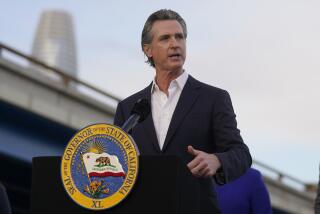With Prices Rising, Big Oil’s Latest Cleanup Challenge Is Its Own Image : Energy: This time, many say the industry really isn’t to blame. Its problem is credibility.
- Share via
First, it was the Santa Barbara channel oil spill.
Then, the gas lines.
Then, the Exxon Valdez.
Now, it’s the Middle East crisis and gasoline prices up 30 cents a gallon and oil prices above $40 a barrel.
So what does the oil industry say about it? It’s not our fault.
That was the underlying message from top oil executives and government officials at the American Petroleum Institute’s annual meeting, the oil industry’s main get-together that occurred last week in Chicago.
Even W. Henson Moore, deputy secretary of energy, and Manual Lujan Jr., the Interior secretary, delivered keynote addresses praising the industry and its actions during the current crisis.
Still, admitted Mobil Corp. Chairman Allen E. Murray, who is also API chairman: “We have a credibility problem.
“I don’t think we’ve been making clear to the American people what contributions we have made, and what a high-tech and complicated business we are,” he said. “The only way you really turn something like that around in the long term is through example and by doing things, but certainly we’ve got to do a better job than we’re doing.”
He also put some of the blame on the public: “I feel that people . . . don’t want to accept the fact that they may be part of the situation. They’d like to think they’re being taken advantage of . . . and we’ve got a bad image, so what have (critics) got to lose?”
At least one critic remained unimpressed. Nicholas Fedoruk, environmental policy director for Citizen Action, a consumer group in Washington, laughed at the suggestion that the public played a role in the current situation: “If they’re expecting to generate sympathy for the oil industry, they’re barking up the wrong tree.”
As for the industry’s credibility, he argued that explanations of gasoline price increases have contained inconsistencies: “One of the problems with their credibility is that they better figure out what their story line is.”
As the oil industry faces a federal investigation into gasoline price-gouging and an outcry from the public and consumer groups about oil profits and high prices, defensiveness was the mood of the three-day API conference attended by more than 1,000 industry people. Consider:
* John B. Boatwright, an Exxon Corp. economist, defended the oil industry’s handling of the current crisis, saying that although prices were high, no shortages of crude oil or refined products had developed.
* Moore defended the industry against charges of gasoline price-gouging, saying his department has found no evidence that prices were being driven by anything other than market forces.
* Z. Lou Guttman, chairman of the New York Mercantile Exchange, defended the operation of the oil and gas futures markets, denying criticism that wild speculation was fueling volatile price swings and driving crude oil prices to unreasonable levels.
* Lujan defended his department’s push for opening environmentally sensitive areas to oil drilling, including the Outer Continental Shelf of California and the Arctic National Wildlife Refuge.
Amid the denials were facts describing the industry’s condition in the 15th week of the Middle East crisis.
There is no shortage of oil. Moore said the worldwide production of crude oil is actually 200,000 barrels a day above levels before Iraq invaded Kuwait on Aug. 2.
At the same time, world demand for petroleum has fallen 400,000 to 700,000 barrels a day, mainly because of the slowdown of world economies, Boatwright said.
Although refining capacity remains tight, shortages of gasoline, heating oil and other products will emerge only if there are unforeseen refinery accidents, extreme cold weather or consumer hoarding, he said. Only propane may be in short supply, Moore said.
But gasoline pump prices probably won’t fall soon. Does that mean that oil companies are gouging the public? No, executives said.
The increase in the prices of gasoline and refined products other than jet fuel have not caught up with the run-up of crude prices, from which those products are made, they argued.
Only an Exxon official disagreed. “About October, I think, we were getting back to where we were starting to make money again, and I assume we’re still in that mode in November,” said Lawrence G. Rawl, Exxon’s chairman. “The fact is, I think that prices have caught up with crude, and crude prices have come down.”
In any case, executives said they thought that refiners would try to hang on to high gasoline prices as long as the market would allow to recoup costs incurred during the third quarter.
“If (crude) prices go down, as we think is most likely, military events apart, then you’ll see us . . . try to get our (profit) margins to more normal levels so that we can generate cash to reinvest,” said James Ross, president of BP America Inc., the U.S. subsidiary of British Petroleum. “Then you’re going to see the (gasoline) price go down.”
Not everyone buys the explanation. “When the price of crude oil and gasoline were going up so quickly after the invasion, they were saying that the market is just doing this terrible thing here and that it’s different from way it used to be because the markets are so much more efficient,” Citizen Action’s Fedoruk said.
“But when crude oil prices drop, they say, ‘We restrained ourselves because of concern by the President and the minority leader in the Senate, and now we have to keep prices up to cover the increased cost of increased crude,” he said. “That’s a contradictory message: On the one hand, they control the market, and on the other hand, they don’t. . . . Well, they’ve obviously got more control over price than they’re willing to acknowledge.”
In any case, have oil companies tried to hide their profits? “I’m so tired of this kind of crap,” Murray told reporters with exasperation. “You make the suggestion that people just have books and can do whatever they want. I mean, there is a certain amount of discretion, but not like that,” he said.
In the third quarter, which covered the first two months of the crisis, net income for a sample of 20 leading U.S. oil companies was $4.5 billion, up 16.8% from the like quarter a year ago, the API reported. Excluding special items, net income was unchanged, the API said.
Has the oil industry driven crude oil prices too high? Both President Bush and some federal legislators have accused oil traders of “speculation” that has driven oil prices as high as $41 a barrel, despite all indications that world supplies of oil are adequate.
“Every time somebody clears his throat in the Middle East or elsewhere, the price goes up and down,” Rawl said.
Executives generally agreed that crude oil prices, based solely on the fundamentals of supply and demand, should be in the $20-to $25-a-barrel range.
But Guttman, chairman of the Merc, disputed the criticism that wild speculation was to blame. He pointed out that 92% of those who trade on the Merc were commercial customers--that is, oil companies or others who trade oil because they use it, not because they want to make a fast buck on the commodities markets.
Oil executives said the futures markets merely placed a price on the real concern that a war would disrupt supplies. “There always has been a need to deal with people’s anticipation of what was going to happen in the future; this simply puts it on the screen,” said Texaco Chairman Alfred C. DeCrane Jr.
Lujan recommended formation of a commission to look into the operation of the oil and gas futures markets, similar to one chaired by Treasury Secretary Nicholas F. Brady that recommended reforms to the stock markets after the October, 1989, crash. So far, there’s been no move to create such a commission.
If war breaks out, executives foresee crude oil prices soaring, then falling if no serious damage is done to Saudi oil installations, as expected.
Once the crisis is resolved, executives predict, oil prices will actually plunge below pre-invasion levels, which were about $21 a barrel, until the current high worldwide oil production levels can be scaled back to match demand.
“In the real short term, (there is) potential for a substantial drop,” BP’s Ross said.
In the end, world crude oil prices should stabilize in the low to mid-$20-a-barrel range, although higher than before the invasion.
Beyond the facts, industry officials agreed on the need to improve public relations.
The executives especially saw a need to sell the public on its agenda: opening up public lands to more drilling, encouraging conservation, reducing reliance on foreign imports, further deregulation and new financial incentives.
It won’t be easy, Murray admitted. “When you have little credibility, two things happen. One, people won’t listen to you, which is understandable. The other is, we become a target. . . . Politically, it’s a no-lose situation to pick on (us) without facts.”
NO MORE MUM’S THE WORD
Troubled companies are no longer keeping silent about their fiscal woes. Many are hiring public relations specialists to handle the news. D8
More to Read
Inside the business of entertainment
The Wide Shot brings you news, analysis and insights on everything from streaming wars to production — and what it all means for the future.
You may occasionally receive promotional content from the Los Angeles Times.









